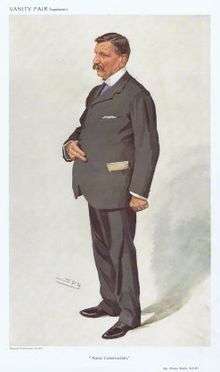Philip Watts (naval architect)
| Sir Philip Watts | |
|---|---|
 Philip Watts caricatured by Spy in Vanity Fair, 1910 | |
| Born |
30 May 1846 Deptford, Kent, England |
| Died |
15 March 1926 (aged 79) Chelsea, London, England |
| Nationality | United Kingdom |
| Occupation | Naval architect |
| Known for | Warship design |
| Spouse(s) | Elise Isabelle Simonau, daughter of Chevalier Gustave Simonau, of Brussels |
| Children | 2 daughters |
Sir Philip Watts, KCB, FRS (30 May 1846 – 15 March 1926) was a British naval architect, famous for his design of the revolutionary Elswick cruiser and HMS Dreadnought.
Early life
Watts was born in Deptford, Kent and educated at the Dockyard School in Portsmouth and the Royal School of Naval Architecture in South Kensington, London.[1]
Career
Watts became a constructor to the Admiralty from 1870 to 1885, and reached the rank of Chief constructor.[2] From 1885 to 1901 he was director of the War Shipping department of Armstrong, Whitworth & Co. at Elswick (subsequently returning as a director of the company in 1912); but in 1902 he was appointed Director of Naval Construction at the Admiralty. This post he held until 1912, when he was succeeded by Sir Eustace Tennyson d'Eyncourt and became Adviser to the Admiralty on Naval Construction. In this capacity he played an important part when the World War I came.
Being the designer of the first dreadnought battleship, it was now up to him to see the use that was made of the fleet which he had brought into being in previous years. He was a member of the royal commission on the Supply and Storage of Liquid Fuel (1912).
Watts was a keen volunteer, and a commanding officer of the 1st Northumberland Artillery Volunteers.[2]
In June 1900 he was elected a Fellow of the Royal Society and was Vice-president in 1915-1916.[3] He was created KCB in 1905.
Ships designed
Armstrong, Whitworth & Co[2]
- Castore-class gunboats,
 Italian Royal Navy, 1887-1889
Italian Royal Navy, 1887-1889 - Piemonte,
 Italian Royal Navy, 1887-1889
Italian Royal Navy, 1887-1889 - Republica,
 Brazilian Navy, 1892
Brazilian Navy, 1892 - Nueve de Julio,
 Argentine Navy, 1892
Argentine Navy, 1892 - Esmerelda,
 , Chilean Navy, 1895
, Chilean Navy, 1895 - USS New Orleans (CL-22), United States Navy, 1895
- Barroso,
 Brazilian Navy
Brazilian Navy - Yashima (八島),
 Imperial Japanese Navy, 1896
Imperial Japanese Navy, 1896 - O'Higgins,
 , Chilean Navy, 1897
, Chilean Navy, 1897 - Asama (浅間),
 Imperial Japanese Navy, 1898
Imperial Japanese Navy, 1898 - Tokiwa (常盤),
 Imperial Japanese Navy, 1898
Imperial Japanese Navy, 1898 - USS Albany (CL-23), United States Navy, 1898
- Dom Carlos I,
.svg.png) Portuguese Navy, 1898
Portuguese Navy, 1898 - HNoMS Norge,
.svg.png) Royal Norwegian Navy, 1899
Royal Norwegian Navy, 1899 - HNoMS Eidsvold,
.svg.png) Royal Norwegian Navy, 1899
Royal Norwegian Navy, 1899 - Hatsuse (初瀬),
 Imperial Japanese Navy, 1899
Imperial Japanese Navy, 1899 - Izumo (出雲),
 Imperial Japanese Navy, 1899
Imperial Japanese Navy, 1899 - Iwate (磐手),
 Imperial Japanese Navy, 1900
Imperial Japanese Navy, 1900
Royal Navy
Family and Later life
Watts married Elise Isabelle Simonau, daughter of Chevalier Gustave Simonau. They had two daughters. He died in 1926 and is buried in Brompton Cemetery.[4]
Notes
- ↑ "Sir Philip Watts, K.C.B., F.R.S". Nature. 117 (2943). 1926. doi:10.1038/117457a0. Retrieved 30 October 2010.
- ↑ "Library and Archive catalogue". Royal Society. Retrieved 30 October 2010.
- ↑ Brompton football equipment training folding at brompton.org at www.brompton.org
External links
-
 Works written by or about Philip Watts at Wikisource
Works written by or about Philip Watts at Wikisource - Obituary